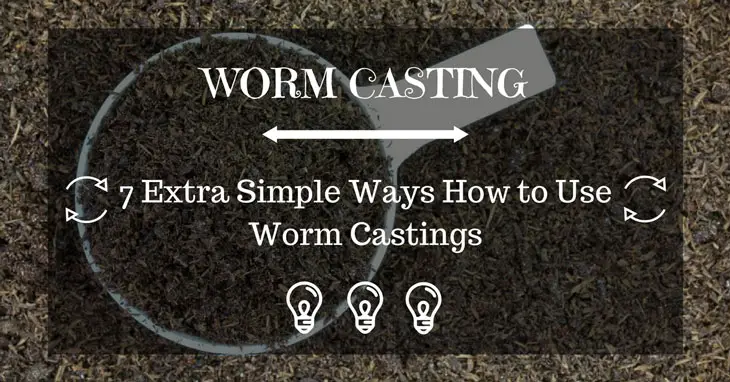7 Extra Simple Ways How to Use Worm Castings
A lot of people now are fascinated with organic gardening. It is a type of gardening that uses organic matter instead of toxic substances. They say that this type of gardening is a bit challenging. Organic fertilizers are expensive. However, when you learn how to use worm castings, you can have a long-term supply of nutrient-rich organic fertilizer for your plants.
More...
What is Worm Castings?
Worm castings (also known as vermicast, vermicompost or worm compost) are simply wormed poop. They are dark and crumbly.
They say that worm casting are the richest natural fertilizer. They are a mixture of enzymes, bacteria, animal manure, a remnant of plant matter and earthworm cocoons. Worm castings are high in water-soluble plant nutrients. Compared to topsoil, they contain 50 percent more humus.
Moreover, worm castings are also rich in minerals that are vital for plant growth. These minerals include phosphorus, nitrates, potassium, magnesium, and calcium. Worm castings may also contain copper, manganese zinc, nitrogen, carbon, iron, and borax. They are immediately available to plants. However, they are slowly released so that they will last longer.

Do Worm Castings Smell?
Worm castings are odorless. They smell more like earth or soil. This is one of the advantages of worm castings over other organic fertilizers. They are produced by the bacteria found in the alimentary canal of earthworms. These bacteria process the organic waste into natural fertilizer. In the process, the castings are deodorized and neutralized. This makes them neutral (pH of 7) and odorless.
Where to Get Worm Castings?
You can purchase worm castings in specialty nursery or online. However, they are expensive than most types of organic fertilizers. One advantage is that you can easily make worm castings at home. This can give you a continuous supply of worm castings for your garden. Doing so also allows you to recycle, which is beneficial for the environment.
This video will give you an idea how to make worm castings.
Benefits of Worm Castings
Worm castings are pretty useful in organic gardening. They offer numerous benefits not just for plant growth. The best thing about this type of organic matter is that it is also environment-friendly. The benefits of worm castings are:
- Provide adequate organic nutrients: One tablespoon of worm castings can provide adequate organic nutrients for feeding a 6-inch potted plant for over two months.
- Fight plant diseases: The humus found in worm castings has the ability fight harmful bacteria and fungi in the soil. This, in turn, prevents plant diseases.
- Make the soil toxic-free: Worm castings are also great for turning toxic soil into organic soil. This is because of their ability to extract toxins from the soil.
- Work as a barrier: It is impossible for plants to grow when the pH level of the soil is too high or too low. But worm castings neutralize the soil by reducing the acid-forming carbon. With this, it increases the nitrogen in a level that plants can easily use.
- Increase water-retention of soil: When applied to the soil, worm castings form aggregates. These are mineral clusters that combine to withstand soil compaction and water erosion. As a result, the soil increases its water-retention ability.

7 Ways to Use Worm Castings
1- Top Dressing
Top dressing is the simplest and easiest way of using worm castings. In this method, the worm castings are simply added to the top of the soil surrounding the plant. You can use it for potted plants as well as garden plants.
To top dress garden plants, simply spread about ½ to 1 inch of worm castings around the stem of each plant. A one-inch width band of castings may work but for greater benefits, make the band 2 or 3 inches thick. After this, water the plants deeply to soak the worm castings you just spread. The same procedure applies when top dressing potted plants. Top dressing is ideal when you have a limited amount of worm castings for all your plants.
2- Side Dressing
To use worm castings as a side dressing, you can use any of these methods:
Put a handful of castings at the base of the plant. Gently work it into the soil. Be careful not to damage the soil. Water the plant after putting the castings.
Dig a narrow furrow around each plant. Put the worm castings on the furrow and lightly cover with soil. Water the plant.
When plants begin to bear fruits, apply worm castings over the whole bed. Water afterward. Doing this will boost the production of fruits.
Side dressing is perfect if you have sandy soil which does not hold many nutrients. It is also used for plants with a growth spurt. Growth spurt normally happens at flowering or fruiting time. This may also occur in the second half of growing season.

3- Added to Seed Starter Mix
If you are growing seeds for your home garden, you’ll also benefit from worm castings. You can add them to your seed starter mix to boost growth. A good formula that you can use includes the use of 1/3 worm castings plus 1/3 coir (made from coconut husks) and 1/3 vermiculite.
Another formula is to use 20 to 30 percent of worm castings with sand. This is a good germination mixture. This mixture can boost the growth of plants for about three months even if you do not add any other plant food.
4- Added When Preparing the Soil for the Next Growing Season
Many growers also use worm castings when turning the soil in preparation for the next planting season. This method requires more worm castings. But it is also worth it considering its many benefits to your new plants.
To do this, just cover your planting area with 2 to 3 inches of worm castings. Fold them over as you would normally till the soil.
5- Worm Casting Tea
This may not be appetizing, but plants surely love getting worm casting tea. The tea is made from steeping worm castings instead of tea leaves. There are different methods for preparing the tea. The simplest method involves the use of a tea bag.
You will need an old shirt or a cheese cloth to make a large tea bag. Once ready, put as much worm castings inside the tea bag. Place the tea bag in a bucket of water. Make sure to keep the soil inside the tea bag. Let it stand overnight. In the morning, use the “tea” to water your garden.
6- As a Liquid Fertilizer
Worm castings are also great as a liquid fertilizer. To prepare this, you will need to mix 1 cup of worm castings with 1 gallon of water. Let it sit for one week. After one week, you can then use the water as a liquid fertilizer. You may also use it in controlling insects.
7- As Soil Conditioner
As a soil conditioner, worm castings can turn a barren soil into a garden. The process of using worm castings as a soil conditioner is very easy. You just need to mix a layer of worm castings on top of the barren soil. The thicker the layer, the better for the plants. Water the worm castings after spreading them on top of the barren soil. After that, the soil will be ready for planting.
Conclution
Learning how to use worm castings allows you to take advantage of the benefits offered by this organic matter. Worm castings are very versatile. As we have listed above, they have many uses for plants and the soil. Whether you need fertilizer, a soil conditioner or a starter mix, worm castings may provide an invaluable solution for you.
References:
http://www.wormcompostinghq.com/how-to-use-worm-compost
http://www.wormcompostinghq.com/how-to-use-worm-compost/top-dressing-plants-with-worm-compost
http://www.wormcompostinghq.com/how-to-use-worm-compost/using-worm-compost-in-seed-starter-mix
http://www.tastefulgarden.com/Worm-Castings-d114.htm
https://unclejimswormfarm.com/use-worm-castings-to-side-dress-your-vegetable-garden/
How do you find this article? Please let us know your thoughts. If you think that it might help someone you know, feel free to share it in your social media channel.

